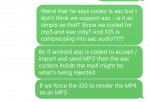Buzzword Consulting
Newbie
We are developing a music app and the ios version can open videos sent from android but not all androids can open iOS.
All have 9.0 android
Specifically, the google pixel 3 can open them but the Samsung GALAXY S9 and S10 cannot.
Those same phones can also only upload smaller photos to our video feature and rejects larger photos but can accept larger photos for profile image.
Is anyone aware of an issue for Samsung galaxy android devices why they wouldnt be able to open a video rendered into mp4 format on an iOS phone?
From what I understand, the OS matters for the coding but the hardware can effect as well.
S9 is verizon, s10 and pixel 3 are tmobile phones and both ios phones (xs max and 6 plus) are on verizon.
Thanks in advance to anyone who might have some idea.
Katya
All have 9.0 android
Specifically, the google pixel 3 can open them but the Samsung GALAXY S9 and S10 cannot.
Those same phones can also only upload smaller photos to our video feature and rejects larger photos but can accept larger photos for profile image.
Is anyone aware of an issue for Samsung galaxy android devices why they wouldnt be able to open a video rendered into mp4 format on an iOS phone?
From what I understand, the OS matters for the coding but the hardware can effect as well.
S9 is verizon, s10 and pixel 3 are tmobile phones and both ios phones (xs max and 6 plus) are on verizon.
Thanks in advance to anyone who might have some idea.
Katya



